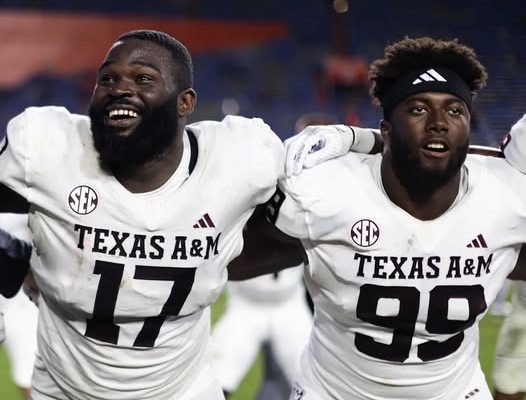**Texas A&M’s Wide Receiver Corps Features New Talent; Can This Group Finally Reach the 1,000-Yard Milestone?**
For years, Texas A&M football has been known for its explosive offenses, high-flying passing attacks, and standout wide receivers. From Mike Evans to Christian Kirk, the Aggies have produced some of the most dynamic pass-catchers in college football. Yet, despite this rich tradition, one milestone has remained elusive in recent years: a 1,000-yard receiver. The last Aggie to surpass that mark was Josh Reynolds in 2016, and since then, A&M’s receiving corps has been productive but hasn’t had a true breakout star.
Heading into the 2024 season, however, there’s renewed optimism. With a mix of promising newcomers and returning talent, Texas A&M’s wide receiver room looks deeper and more explosive than it has in years. The question now is whether this group can finally produce that coveted 1,000-yard season.
### **The Recent Drought**
To understand why reaching 1,000 yards has been so difficult for A&M receivers lately, we have to look at the offensive structure and quarterback play. Under Jimbo Fisher, the Aggies often utilized a run-heavy approach, spreading the ball among multiple receivers rather than locking in on a single star. Additionally, inconsistent quarterback play—whether due to injuries or performance—has made it harder for any one receiver to dominate statistically.
Even talented players like Ainias Smith, who was a versatile weapon in the slot, never quite reached the 1,000-yard mark despite being a key contributor. Last season, Evan Stewart led the team with 514 receiving yards—a solid number, but far from the benchmark Aggie fans hope to see.
### **New Faces, New Potential**
This season, the Aggies have reloaded with an influx of talent that could change the narrative. The most notable addition is **five-star freshman Cam Coleman**, one of the top-ranked receivers in the 2024 class. At 6’3” with elite speed and ball skills, Coleman has the tools to be an immediate difference-maker. His ability to win contested catches and stretch the field vertically gives A&M a dimension they’ve lacked in recent years.
But Coleman isn’t the only new weapon. **Jahmal Banks**, a transfer from Wake Forest, brings experience and production. At 6’4”, Banks is a physical possession receiver who had 59 catches for 653 yards last season. His reliability in the intermediate passing game should be a major asset.
Returning players also add depth. **Noah Thomas** (6’6”) showed flashes of dominance last season with his red-zone prowess, while **Jabre Barber** and **Micah Tease** provide speed and versatility. If sophomore **Evan Stewart** stays healthy and fully buys into the new offensive scheme under coordinator Collin Klein, he could finally have the breakout year many have anticipated.
### **The Impact of the Offensive Scheme**
A major factor in whether a receiver reaches 1,000 yards is the offensive system. Under Fisher, A&M’s passing game was often criticized for being too conservative and predictable. Now, with **Collin Klein** taking over as offensive coordinator (after a successful stint at Kansas State), there’s hope for a more dynamic, receiver-friendly approach.
Klein’s system at K-State emphasized getting playmakers the ball in space, utilizing pre-snap motion, and taking calculated deep shots. If he can implement a similar philosophy at A&M, the Aggies’ receivers should see more opportunities for big plays. Additionally, with **Conner Weigman** returning at quarterback—assuming he stays healthy—the passing game should be more consistent than in recent years.
### **Historical Context: Why 1,000 Yards Matters**
Reaching 1,000 receiving yards in a season is more than just a statistical milestone—it’s a sign of offensive dominance. When a team has a 1,000-yard receiver, it usually means the passing game is efficient, the quarterback is playing at a high level, and defenses are forced to adjust. For A&M, hitting that mark would signal that the offense has taken a step forward.
Looking back, the Aggies’ most successful seasons (like Johnny Manziel’s Heisman year in 2012) featured a clear No. 1 receiver. Mike Evans’ 1,394-yard season in 2013 was a key reason A&M remained competitive in the SEC. If this year’s group can produce a true alpha, it could elevate the entire offense.
### **Who is the Most Likely Candidate?**
If A&M is going to have a 1,000-yard receiver in 2024, who will it be?
1. **Evan Stewart** – The most obvious choice. Stewart has elite speed and route-running ability, and if he stays healthy, he could finally put together a complete season.
2. **Cam Coleman** – True freshmen rarely dominate, but Coleman’s talent is undeniable. If he adjusts quickly to college ball, he could be a dark horse.
3. **Jahmal Banks** – The Wake Forest transfer might not have Stewart’s explosiveness, but his reliability could lead to a high volume of catches.
4. **Noah Thomas** – His size makes him a red-zone nightmare, but he’ll need to expand his role beyond just jump balls.
### **Challenges to Overcome**
Even with the new talent, there are obstacles:
– **QB Consistency**: Weigman has shown promise, but injuries have been an issue. If he misses time, the passing game could suffer.
– **Competition for Targets**: With so many weapons, will one receiver get enough targets to reach 1,000 yards?
– **SEC Defenses**: The Aggies face some of the best secondaries in the country. Dominating against Alabama, LSU, and Georgia is no easy task.
### **Final Verdict: Will It Happen?**
The pieces are in place for Texas A&M to finally produce a 1,000-yard receiver. The combination of elite young talent, experienced transfers, and a new offensive scheme creates the perfect storm. If the quarterback play is steady and one receiver emerges as the clear go-to option, the drought could end in 2024.
Evan Stewart is the safest bet if healthy, but don’t sleep on Cam Coleman making an immediate impact. Regardless of who does it, Aggie fans should be excited—this might finally be the year the 1,000-yard curse is broken.



